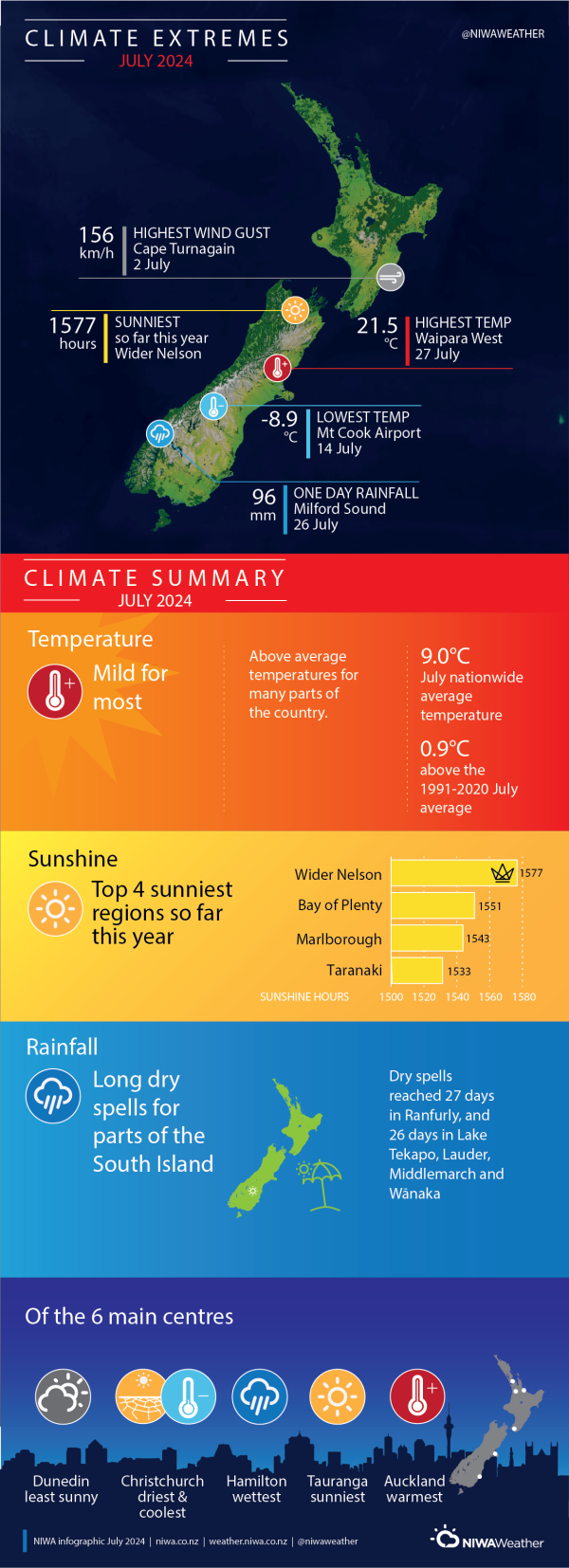Mild and dry for much of the country
| Temperature | Above average (0.51-1.20°C above average) or well above average (>1.20°C above average) temperatures were observed for western and southern parts of Northland, Hawke’s Bay, Wairarapa, and northern, western and coastal parts of the South Island. Near average temperatures (±0.50°C of average) were observed in parts of Auckland, Bay of Plenty, Waikato, northern Taranaki, coastal Manawatū-Whanganui, and inland parts of the South Island. |
| Rainfall | Rainfall was below normal (50-79% of normal) or well below normal (<50% of normal) for much of the North Island, and parts of Marlborough, Nelson, northern and central Canterbury, West Coast, and Southland. Above normal (120-149% of normal) or well above normal (>149% of normal) rainfall was observed in most of Otago, southern Canterbury, Banks Peninsula, and the Bay of Islands. |
| Soil Moisture | At the end of July, soil moisture levels were near normal for most of the country. Below normal soil moisture was observed in central and northern parts of Canterbury. Above normal soil moisture was observed in coastal parts of southern Marlborough. |
Overview
July 2024 mean sea level air pressure (MSLP) was higher than normal over and to the south of Aotearoa New Zealand. This was associated with more southeasterly winds than normal. A large and slow-moving high pressure system was present over New Zealand for much of July, leading to an extended period of fine and settled weather, and regular heavy frosts for inland areas. The strength of the high pressure peaked on 10 July, when Ranfurly registered a MSLP of 1046.5 hPa – this is mainland New Zealand’s highest MSLP measurement on record.
It was a relatively mild July for much of New Zealand, with above average (0.51-1.20°C above average) or well above average (>1.20°C above average) temperatures observed for coastal parts of Southland, Otago and Canterbury, West Coast, Marlborough, Nelson, Tasman, Wairarapa, Hawke’s Bay, southern Taranaki, northern Gisborne, and southern and western Northland. Near average temperatures (±0.50°C of average) were observed in parts of inland Southland and Otago, central and northern Canterbury, coastal Manawatū-Whanganui, northern Taranaki, Waikato, Bay of Plenty, Auckland, and eastern Northland. Isolated pockets of below average (0.51-1.20°C below average) temperatures were observed in the Central Plateau and Central Otago. Overall, the nationwide average temperature in July 2024 was 9.0°C. This was 0.9°C above the 1991-2020 July average, making it New Zealand’s 8th-warmest July since NIWA’s seven station temperature series began in 1909.
July rainfall was below normal (50-79% of normal) or well below normal (<50% of normal) for southern parts of Northland and Auckland, much of Waikato, Gisborne, Taranaki, southern Hawke’s Bay, the Central Plateau, Manawatū, Greater Wellington, northern Marlborough, Nelson, southern Tasman, northern and central Canterbury, West Coast, and Southland. Above normal (120-149% of normal) or well above normal (>149% of normal) rainfall was observed in most of Otago, southern Canterbury, Banks Peninsula, and the Bay of Islands. For the areas that were wetter than normal, most of the rainfall occurred during two events (at the start and end of the month, respectively). For example, Lauder recorded 51 mm of rain during July, but 46 mm of that total occurred on 1 July and 29 July. In between those events, Lauder observed a 26-day dry spell from 2-27 July.
Further highlights:
- The highest temperature was 21.5°C, observed at Waipara West on 27 July.
- The lowest temperature was -8.9°C, observed at Mt Cook Airport on 14 July.
- The highest 1-day rainfall was 96 mm, recorded at Milford Sound on 26 July.
- The highest wind gust was 156 km/h, observed at Cape Turnagain on 2 July.
- Of the six main centres in July 2024, Auckland was the warmest, Christchurch was the driest and coolest, Hamilton was the wettest, Tauranga was the sunniest, and Dunedin was the least sunny.
- Of the available, regularly reporting sunshine observation sites, the sunniest four regions in 2024 so far are wider Nelson (1577 hours), Bay of Plenty (1551 hours), Marlborough (1543 hours) and Taranaki (1533 hours)


